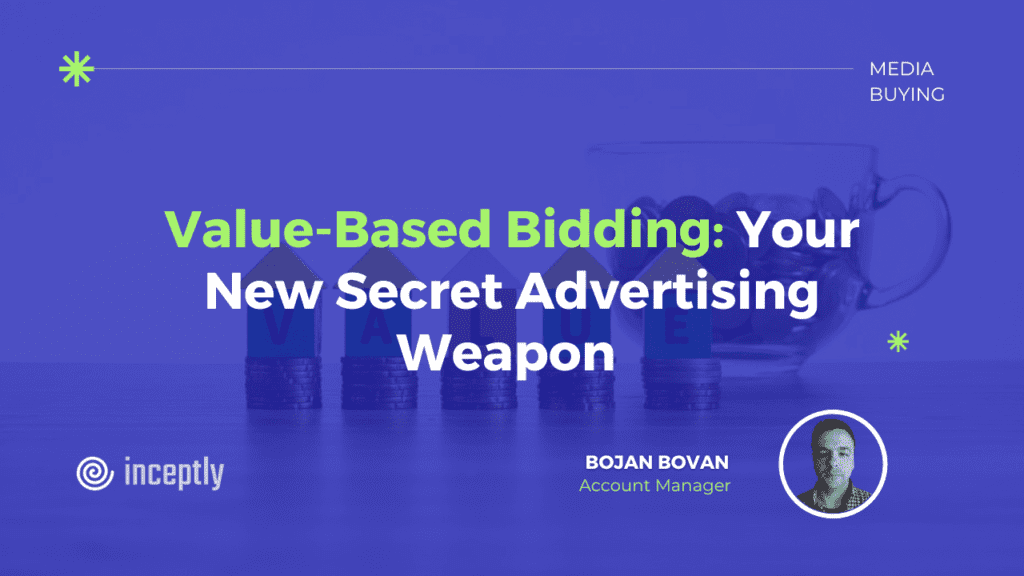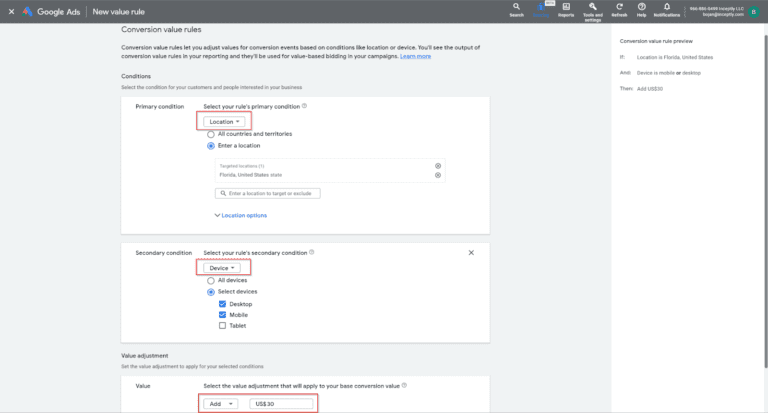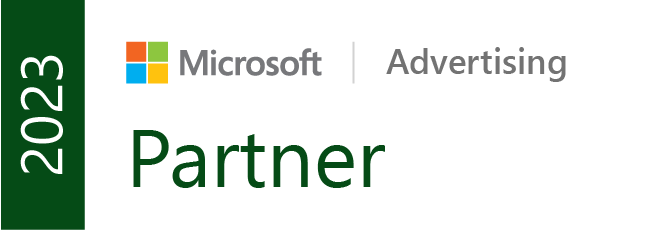
Are you stuck in a loop, experimenting with CPA and Maximise Conversion bidding strategies, but feeling like you’re going in circles?
Well, today, we’re about to break that cycle and introduce you to a bidding strategy that’s definitely worth testing and, most importantly, how it can benefit you.
Before we dive into this exciting strategy, let’s establish a common goal. Isn’t the ultimate objective of digital advertising to maximise your return on investment (ROI)?
Here’s where our secret weapon comes into play: the Value-based Bidding Strategy (MCV/T-ROAS).
Want to brainstorm with our team on new ways to scale your business with YouTube Ads (and other performance video platforms)?
Join us for a free YouTube ad brainstorming session:
VBB is one of the eight automated bidding strategies provided by Google Ads. This strategy entails the modification of your bids for keywords or placements, considering the estimated value of the resulting traffic. The value can be defined using metrics like expected return on ad spend (ROAS), customer lifetime value (CLV), or profit margin.
How is value-based bidding different from other bidding strategies?

Value-based bidding differs from other bidding strategies in Google Ads in its focus on the projected value of the conversion rather than the cost per click (CPC) or cost per acquisition CPA. This enables you to bid based on the value of a single action, such as a sale or a lead, and helps you reach your desired outcome at the lowest possible cost. Some bidding strategies in Google Ads, such as manual bidding, maximise clicks are CPC-focused and do not consider the anticipated value of conversion, so using this bidding strategy can help AI understand your desired return of ad spend a lot better and optimise around that.
How does VBB actually work?
Advertisers assign specific values to various conversion actions, considering factors such as anticipated revenue, profit margin, or customer lifetime value associated with each conversion. The bidding strategy subsequently adjusts bids, prioritising keywords or placements with a higher likelihood of yielding conversions of greater value.
Here is the comparison between VBB and its key values, and other bidding strategies.
By setting the VBB strategy, you are giving Google a signal that your goal is not just getting sales but rather pointing to maximise the return on investment (ROI). This strategy proves advantageous when handling products or services with diverse levels of profitability or when targeting particular audience segments that are more inclined to yield conversions of higher value, while other bidding strategies in Google Ads, such as manual bidding, CPA, CPC, and maximising conversions do not consider the anticipated value of a conversion and do not optimise around that.
The requirement to be eligible to use VBB (Maximise conversion value or target ROAS) is to have at least 15 conversions on the account level.

Tip: When using the VBB strategy (depending on the property type, but will take the PMax campaign as an example), the advice is to split products by their margin in separate campaigns so you can set the targets for each category separately and meet your goals tailored to specific product/ product category ROI target.
When it comes to Performance Max campaigns and VBB, you can add an additional layer that will help VBB to work better, which is adding a conversion value rule.
You’ll find it under “conversion” panel” > “value rules.”
Note that Conversion value rules only apply to Search, Shopping, Display, and Performance Max campaigns.
Once set up, you can view your conversion value rules output in the conversion value column in your conversion actions table. These rules will also be used for value-based bidding optimization in your campaigns using Target ROAS bidding, Maximise conversion value bidding, and Performance Max campaigns.
If you report store visits or store sales, you will have an option to select a conversion goal. You may select All conversion goals, Store visits, or Store sales; otherwise, it will be applied to all conversion actions.
Based on your data and how valuable are customers from specific countries or specific devices, and audiences, you will add values to that specific category under just primary or combined under primary + secondary adjustment.
Note: All value rules in your account must use the same type of primary and (optional) secondary conditions. For example, if your primary condition is “Location” and your secondary condition is “Device” for value rule #1, all other value rules must have a “Location” primary condition. If your additional value rules also have a secondary condition, it must be “Device,” so you can’t change the category for primary and secondary conditions selected when creating the first value rule. If you need to change the type of conditions you’re using in your value rules, you’ll need to delete all value rules and create new rules with consistent conditions.


With that input, you will give an additional layer of a signal about which of the conditions you value the most (which provides the best LTV, AOV) so AI can work better in delivering the best ROAS.
Here is how you can segment your conversion value rules in reporting:
In your Google Ads account, click the Campaigns icon,
Click the Campaigns drop-down in the section menu,
Click Campaigns,
Click the segment icon and select Conversions, then Value rule adjustment,
Select one of the segment options below:
Original value (rule applied): Total original value of conversions, which then had a value rule applied.
Original value (no rule applied): Total recorded value of conversions that did not have a value rule applied.
Audience, Location, Device, or No Condition: The net adjustment when value rules were applied.

Keep in mind:
You can set a maximum of 2 conditions per rule.
The secondary condition is optional.
When setting a rule, once you choose your primary condition type, your secondary condition must be a different type.
For example, if your primary condition type is Location (eg, “California”), your secondary condition cannot also be Location.
When you create a value rule, all subsequent value rules must have the same conditions.
You can select more than one option when setting up the rule. The rule will treat each option as an “or” in the preview section.
For example, if you select “New York” and “California”, the rule applies to New York or California customers.
You can adjust values with integers as well as percentages.
If you currently use conversion value with Smart Bidding, particularly Target ROAS bidding or Maximise conversion value bidding, you can apply conversion value rules to optimise toward users who are more valuable to your business. Learn more about the impact of conversion value rules on Smart Bidding.

A couple of important notes:
Campaign structure does matter.
Don’t analyse the performance and jump to conclusions in the learning phase, which is roughly 1-2 weeks.
Don’t set your target ROAS too high out of the gate. The best practice is to set it firstly on the historical level (recommended) and slowly up it while leaving at least a week or two for the campaign to adjust to the new target.
Wrap up
VBB is indeed a powerful bidding strategy that can make a whole turnaround in performance if it’s set and managed properly. So firstly, create a strong marketing plan by analyzing the ROI for each of your products/categories, tailor your bidding strategy according to that, leave enough time for a learning phase, and watch it skyrocket.
Like this post? Let's continue the conversation!
Get in touch with us by shooting us a quick email or tagging us on LinkedIn or Instagram, and sharing your thoughts. Your feedback helps us keep our blog relevant and interesting.

Bojan Bovan, Account Manager
With his extensive background in media buying for some of Inceptly's biggest clients, Bojan is known for his inquisitive mind and attention to detail. He keeps his hand on the pulse of new developments in direct-response advertising and enjoys finding ways to apply innovative strategies and techniques to keep our clients ahead of the curve.
Want to brainstorm with our team on new ways to scale your business with YouTube Ads (and other performance video platforms)?
Join us for a free YouTube ad brainstorming session:



